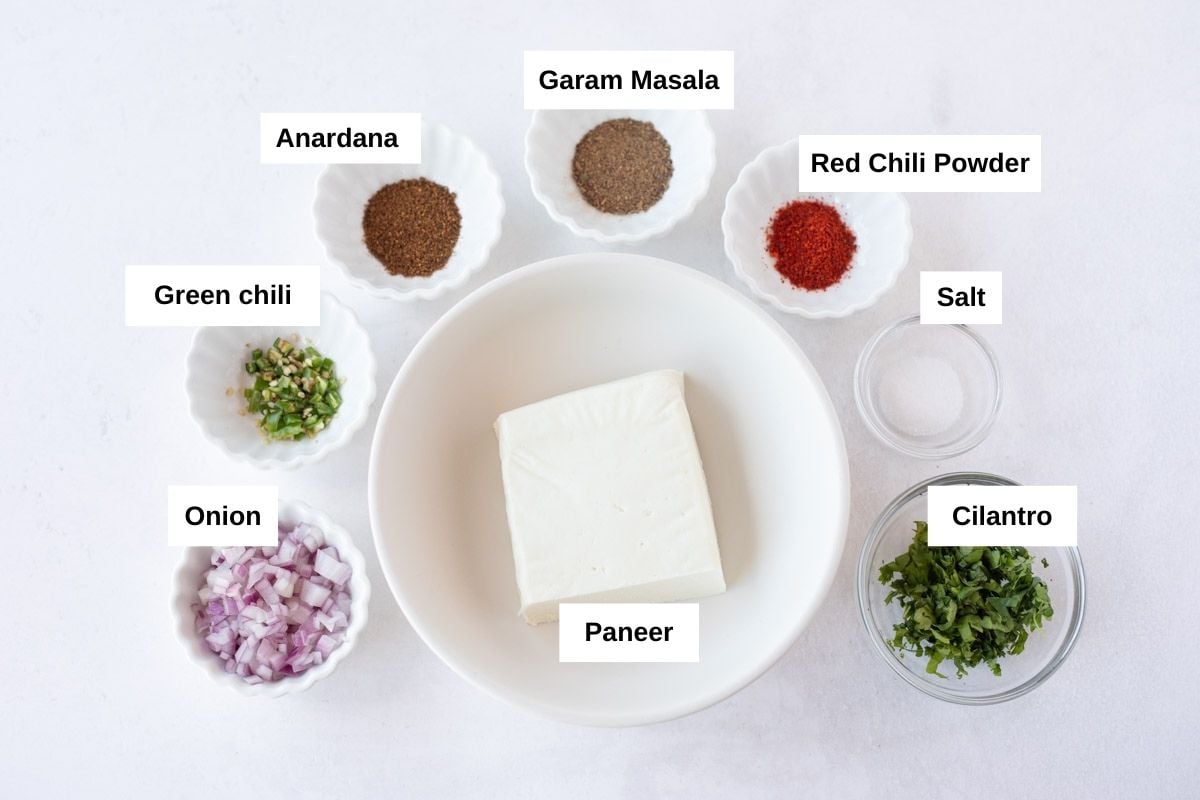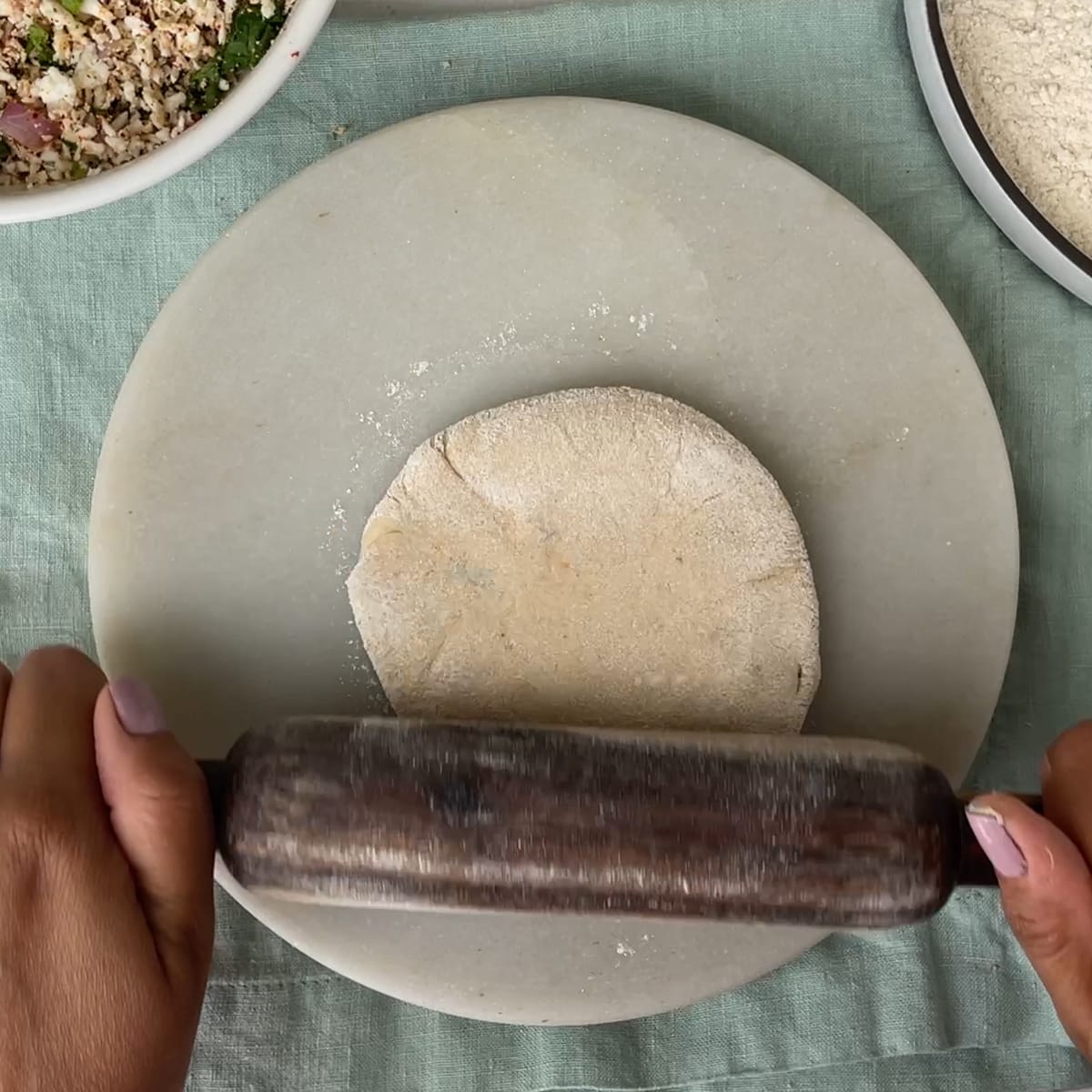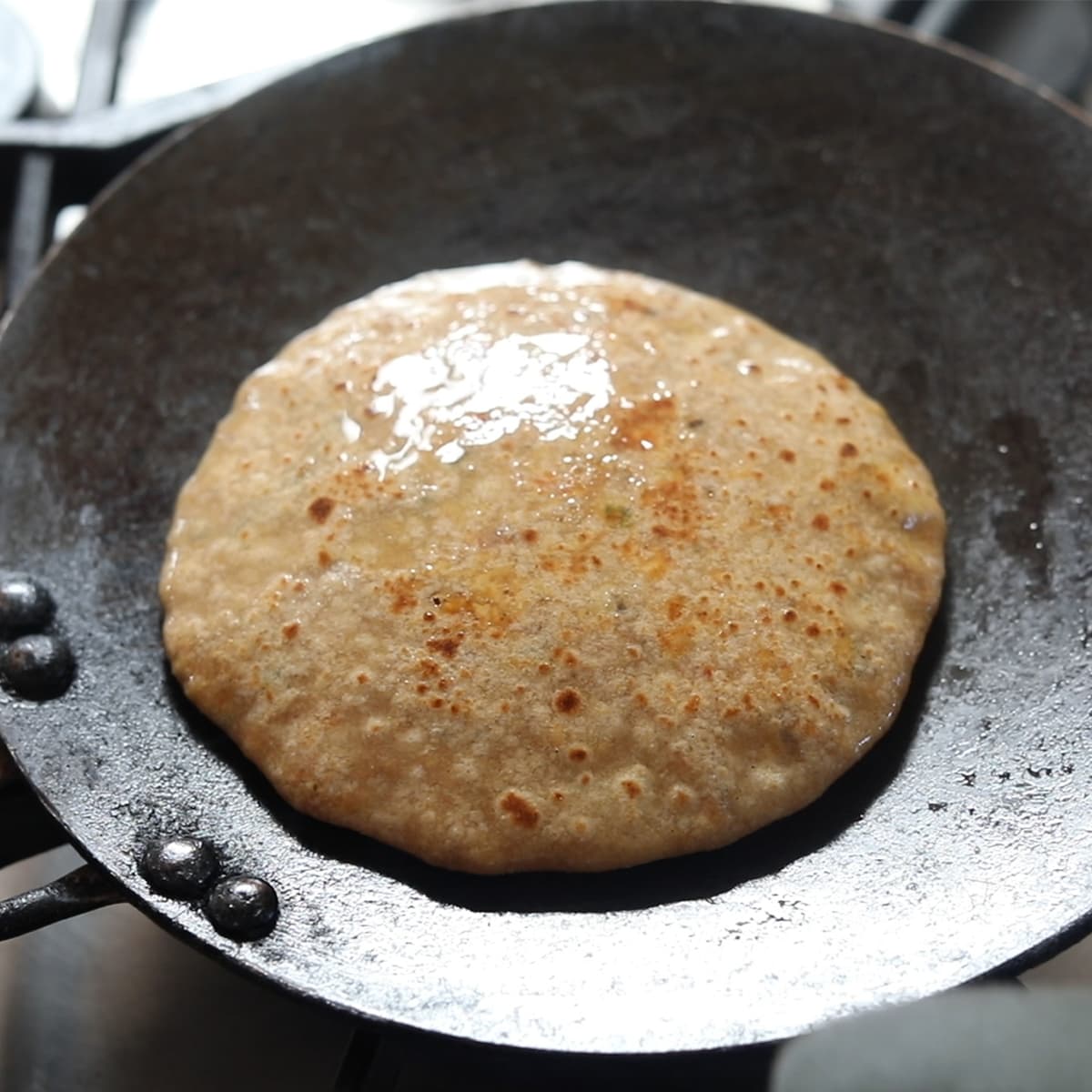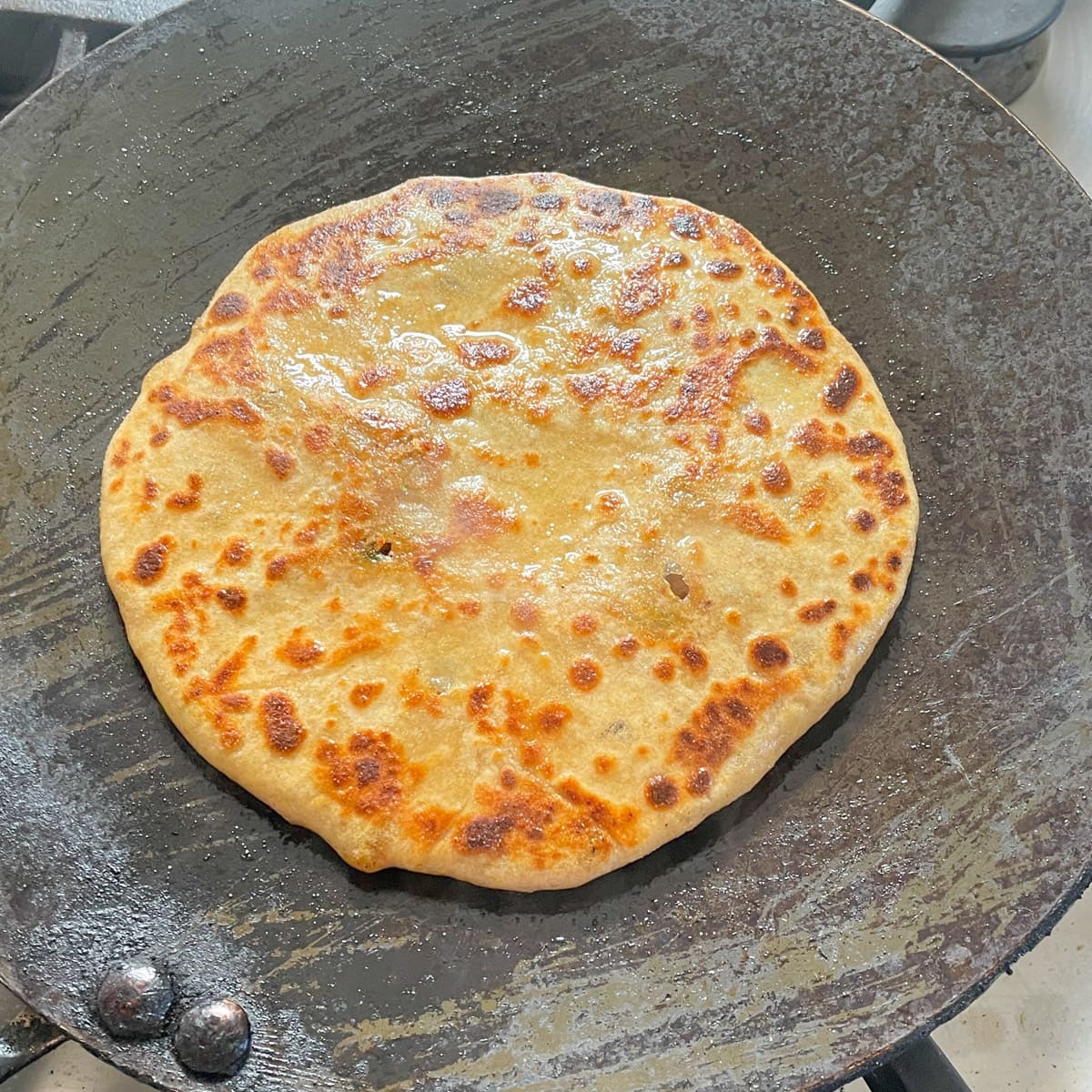These stuffed parathas are authentic North Indian cuisine that so many people all over the world adore. They’re also SUPER SIMPLE to make! When it comes to parathas, you cannot miss aloo paratha and paneer paratha. They are at the top of the chart. I recently shared my mom’s recipe for aloo paratha, methi paratha, mooli paratha, and broccoli paratha, and now I bring you this awesome paneer paratha that I learned from her. You can also try this plain paratha recipe. Stuffed parathas are a no-brainer! These always come to the rescue when I can’t decide what to cook. You can use any filling of your choice and some leftover sabzi like aloo gobi or paneer bhurji. Stuffed parathas are also my go-to main dish for kids’ lunch boxes. My kids like them cut in triangles similar to pizza, as it is like finger food, they can easily enjoy at lunchtime in school.
Watch How to Make Paneer Paratha
What is Paneer Paratha?
Paneer paratha is a pan-fried unleavened Indian flatbread stuffed with a savory Indian cottage cheese mixture. This recipe is spicy and tangy. The garam masala and chopped green chilies add an amazing kick to the somewhat bland paneer. Paneer paratha is wholesome and makes for a satiating breakfast or brunch. This is kid approved and makes a great lunch box option. These parathas are made with simple, readily available ingredients! There’s no need to buy store-bought frozen parathas, as you can make them in a jiffy! So every bite is exploding with flavor that is difficult to resist, and they are a HUGE hit with everyone at home!
Ingredients
Atta (whole wheat flour): The dough is prepared with wheat flour or Atta. You can buy it at the Indian grocery store. Paneer: I have used store-bought Paneer. The paneer is grated with a box grater. You can also crumble the paneer. It recommends grating as the paneer is uniform. You can also use homemade soft paneer at home. Green chili: Lends a spicy aroma and flavor to the bland paneer. But you can skip it if you are not fond of spicy food or have little ones at home. Onions: These are optional but add a wonderful crunch to the parathas. I skip them when making the parathas for my kids. Cilantro/Coriander leaves: Freshly chopped cilantro adds color and flavor to the paratha. I like a lot of cilantro in the filling. Spices: My go-to spices are red chili powder, garam masala, anardana, or amchur powder. Salt: Add according to taste. Oil: A teaspoon of oil is needed for the dough and more for roasting the parathas.
How to Make?
So the paneer paratha process is similar to that of Aloo paratha. Essentially all stuffed parathas can be made in the same manner. It just takes a little practice and patience.
Prepare The Stuffing
Take the store-bought or homemade paneer. Grate it with a box grater, or you can even crumble it. Add red chili powder, garam masala, anardana powder or amchur powder (optional), and salt. Next, add chopped green chilies (optional) and cilantro and combine everything well. I also like to add some chopped red onions for crunch. Taste the stuffing and adjust spices or salt as needed.
Prepare The Dough
The dough for parathas is pretty similar in consistency to roti dough. Take 2 cups of whole wheat flour or Atta in a wide bowl. Make a well in the center. Add ½ teaspoon salt (optional), one tablespoon oil or ghee, and roughly ⅓ to ½ cup water. When mixing and kneading the dough, add more water in small amounts. Do not pour the water all at once otherwise, you will get a slushy mess. Bring the ingredients together and knead for 8-10 minutes to form a smooth, soft dough. If necessary, add more water. Cover and set aside the dough for around 30 minutes to rest. You can even make your dough in the food processor or stand mixer. Here is a post about making roti dough using Kitchenaid stand mixer.
Roll The Paratha
This is the most important step of making stuffed parathas, and you must be careful to avoid tearing the paratha. You can use either of the two methods depending on what you are comfortable with: Disc/ Roti Method: Take two same-size dough balls. With a rolling pin, roll the dough balls into roti/ chapatis of around 6 inches each. Spread the paneer filling on one roti. Wet the edges slightly with water. Place the second roti on top of the filling and gently press the edges to seal them. And then you can roll it further, dusting some atta if you want it thinner. Dumpling Method: I prefer and use this method. Take a medium-sized dough ball. Roll it and then flatten it lightly with the help of your palms. Roll out a roti of about 5 inches in diameter, dusting it with flour. Optionally spread some ghee on the rolled dough. I like to do this, especially when making parathas for kids. Next, place some paneer stuffing in the center, leaving about 1 inch of space from the sides. You can add the filling with the rolled roti in your hand, or it can be easier to leave the rolled roti on the base. Take the edge, make small pleats, and gather the pleats to join in the center. When the pleating is complete, the stuffing will not be visible and will look like a dumpling. Here is a pro tip: Sometimes you have parathas that have thicker dough at the center. To avoid that, you can remove any extra dough at the top of the dumpling. This makes sure that the filling spreads evenly throughout the paratha. Next, flatten this dumpling in the center, sprinkle some flour, and roll it. Make sure the edges are not very thick.
Roast The Paratha
Heat the tawa (skillet or griddle). Place the rolled paratha on the hot tawa. Make sure not to cook parathas on a low flame as they will be hard. Adjust the flame according to the thickness of the tawa. The finished parathas should be crispy and soft at the same time. Use a spatula to flip the paratha once the base is partially cooked. You’ll notice air pockets on this side, and the paratha puffs up. Spread or brush the ghee or vegetable oil on the partially cooked side. Flip it over again, and you’ll see brownish/ golden spots on the surface. To be more specific, the ghee/ oil-slathered side will now be on the bottom. Spread ghee/ oil on the second side and press the edges of the paratha till it is evenly brown and well cooked. Repeat these steps till all the parathas are cooked. Take it off the tawa and serve immediately. Or keep the parathas in an insulated container or a roti basket wrapped in a towel. This will ensure they stay warm when you are ready to eat.
Tips
A few pointers will surely help to get the best paneer paratha.
The dough should be soft and smooth. It is best if the dough is rested for about 15-30 minutes before rolling it. Use fresh soft paneer for the recipe. Stale paneer is hard and bitter. If crumbling, remember to crumble the paneer into smaller pieces. Any lumps or big chunks will tear the paratha. Avoid overfilling the parathas and roll them evenly. When cooking the parathas, ensure the tawa is hot and then cook them on medium-high flame. Roast the parathas with generous amounts of oil. Do not add oil until the paratha is halfway cooked. This trick will improve the cooking process!
Variations
Paneer-Aloo Paratha: This is a classic combination – loved by everyone. The goodness of paneer, when combined with mashed potatoes and stuffed in the paratha, makes the tastiest lunch. Palak-Paneer Paratha: Who doesn’t love palak paneer? You can now make a stuffed paratha by chopping some spinach and combining it with paneer. Paneer-Mint Paratha: Add finely chopped mint leaves to the paneer for a fresh flavor. Use cheese if you don’t have paneer: Follow the same recipe with grated cheese to make chili cheese paratha. Use cheddar, mozzarella, or a combination of both.
How to Serve?
Stuffed parathas are perfect for any meal – trust me, you can have them for breakfast, lunch, or dinner! Most people have paneer paratha with white homemade butter and Indian chai for breakfast. Paneer ka paratha is usually served with mango or lemon pickle, mint, and cilantro chutney, or plain yogurt seasoned with salt and cumin. These parathas taste yummy when served with a curry like aloo sabzi dal makhani, chana dal, or even chana masala and are a complete meal!
Common Questions





















